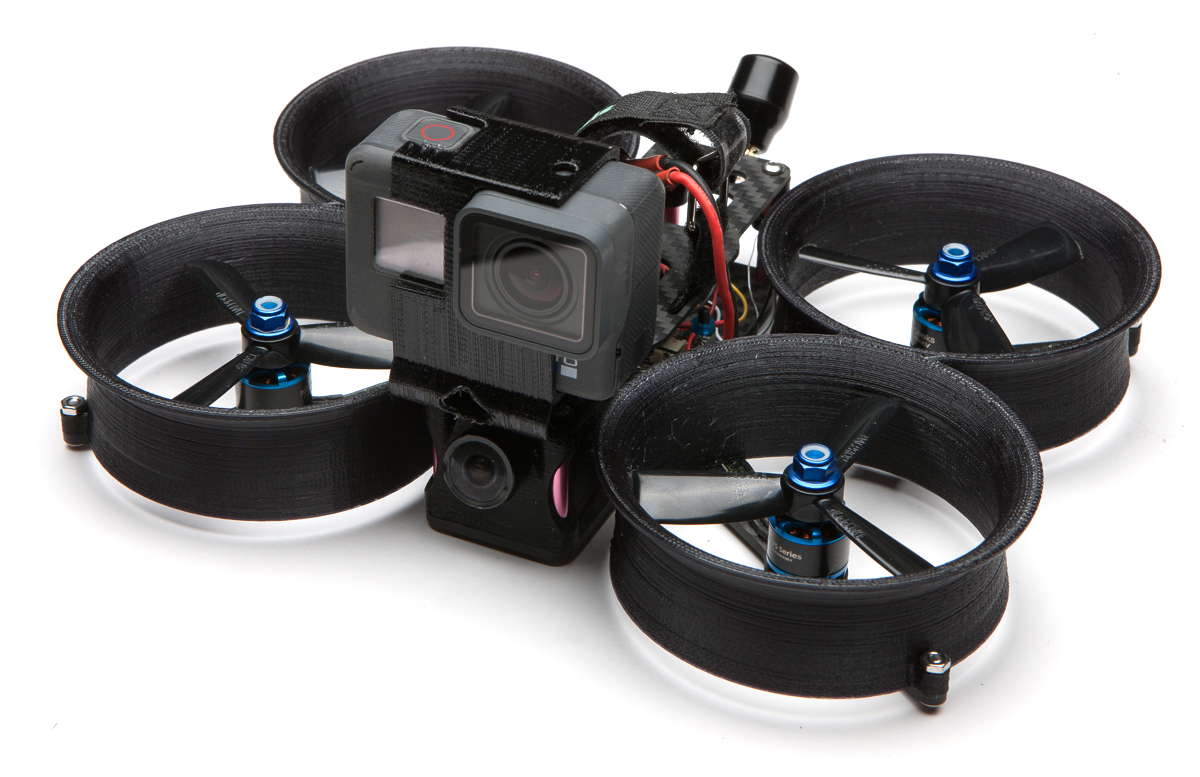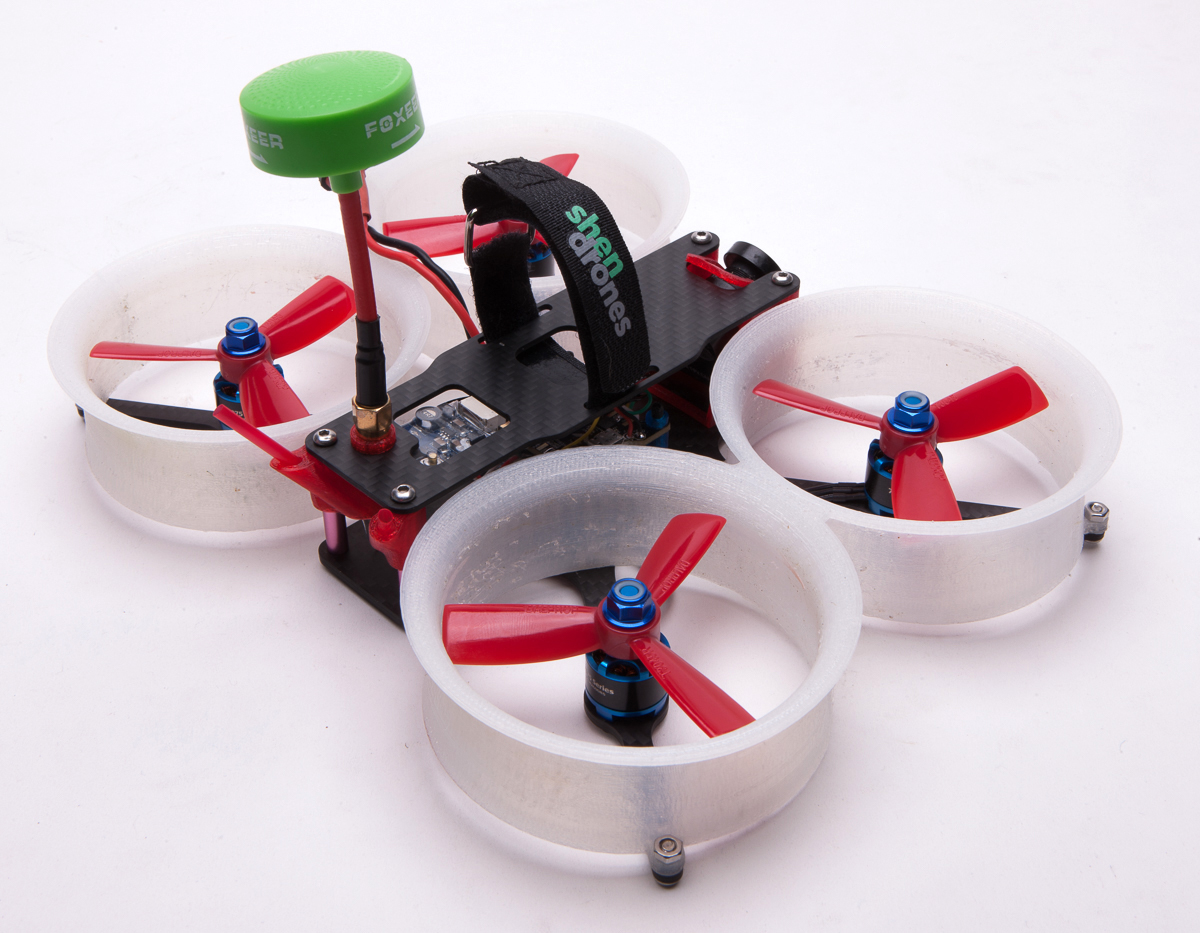
Squirt
I've been working on an AP frame with Gab707, and when Randy Slavin saw it he suggested I send one to Robert Mcintosh. This makes perfect sense: Robert is the pioneer of what you might call 'rate mode aerial photography', producing amazing hybrid videos that, while stabilized, require piloting skills beyond what one can do with a DJI style drone. Check out 'Muscle Up' for a perfect example of his precision flying. Randy put me in touch with Robert and we started chatting.
Turns out that Robert's rigs are nothing like what I was working on. He has 3" and 5" rigs (the 5" rig is built on my Danaus) with prop guards and a servo driven one axis gimbal. Sometime they have 2 vtx's so a second operator can control HD cam tilt. The smaller rigs have decased GoPros. You can see his smaller rig in the thumbnail image of the Muscle Up raw video.
What Robert really wanted was an upgrade to his 3" rig, something that can hit tiny gaps and still carry all that gear well. He also wanted a clean/dirty frame using alpha gel to isolate vibrations. My first thought was a ducted frame, given all the weight and need for prop guards, so job number one was to build a proof of concept to see if I could create a frame that could haul all that mass and still fly well.
The Liberty Ducted Quad has a full top and bottom plate, but to save weight here I opted for just a pared down bottom plate. Then I paired up the ducts on each side into a single print so they could help stiffen things up. The LDQ's ducts are TPU, but these unsupported ducts will have to be nylon. After that the rest was pretty straightforward – it'll all have to be changed to accommodate Robert anyway.
Note that the ducts on each side are tied together for strength.
I built it up with an old Racerstar 4in1, Radiance, and Rotorgeeks 1407 3600kv motors. I intentionally made the ducts really tight to the props. On the LDQ the props always touch the ducts, and the motors grind away the ducts so the gap is as small as possible for maximum efficiency. Here, the 1407's didn't have the torque to overcome the drag, so I had to trim the props, leaving a ~1mm gap.
This is an earlier version of the ducts, where the bottom isn't tied together.
I usually make fpv cam mounts grip the lens barrel, but with the cam safely tucked away behind the ducts I made this mount grip the lens thread, with the lens protruding beyond the mount, so it'll work with any lens. I made the cam mount with 3 tilts, 25-40-55 degrees. The first flight at 25 went well enough (it needed more P and I with the weight of the ducts), so I tried it at 40 degrees next. It flew surprisingly well, very similar to a racing quad in feel, but just waaaaay slower with all that frontal area.
So, it flies well enough, but I wanted to quantify the benefits of the ducts to be sure that they're worth their 64g weight (AUW is 450g with a 1300). I broke out the clamp-down pivot from my arm design thrust stand rig. An old 3/8" dowel from the old tricopter days served as the arm for the thrust stand, with a 3d printed sleeve to act as the fulcrum. The frame was taped to the dowel on one end, and the other end sat on a scale. The scale side was weighted 'til it was just a bit heavier than the frame, and then the scaled was tared. Each run was done on a fully charged battery, readings were taken off a video at 5 frame intervals.
Here's a low speed spin up just to give you an idea how the rig works:
The initial runs were done with throttle at 1453 (just a random mid throttle number that the Betaflight app seemed to like) because I wasn't sure that skinny dowel would hold up at full throttle. I got 616g with ducts on, 554g with ducts off. That 1mm gap was bothering me, so I broke out a fresh set of props and slowly sanded them down until theyjust started to spin freely. With the improved tolerance thrust went up to 648g.
I was curious about the numbers at full throttle, so I did two more quick and scary runs. Thankfully the dowel held and we didn't have a full speed indoor flyaway. At full throttle it was 1953g with ducts, 1710 without, so it seems the ducts are well worth their weight. Raw data is here. Finally, one last check: I increased AUW to 500g with a Session and it hovers at 50% throttle. Robert's 3" rig is 330g with the decased GoPro and an 850, so I think we're on the right track here.
I took it to the FPV Addiction field as a joke, and surprisingly had a great time with it. It was really fun running a race course with it – you have forever to line up the gates, making it easy to learn the course and build confidence without crashing. I could theoretically do the same by lowering the cam tilt on a race frame, but I'm so used to the controls at 45 degrees now it's hard for me to fly with less cam tilt. Here I am running the course, then getting a little overconfident and whacking a tree – lower speed, less inertia, more drag = not drifting out as wide on turns. Cam tilt was at 40 degrees.
The boys were cracking up at how slow but tilted the frame was, so I had to see it LOS for myself. Mellowfpv flew it while I shot this:
I like it so much that I'm releasing it as is (you can order it here). I'm not sure what it is, a trainer, an indoor flyer, a STEM project, I just know it's goofy and fun so if you love flying odd things here's something for you. Now it's time to go back and work on Robert's clean/dirty version.
Part 2
So...about that clean/dirty version. I kinda never got around to it, and Robert didn't pester me, so it just languished. I prefer to design something from beginning to end, but I have no skills with homemade gimbals and de-casing GoPros, so the idea of sending Robert a blank slate for him to drill and dremel was way less appealing than the many other prototypes I had going at the same time.
Then, this dropped.
Naturally we all started speculating about the configuration they used, most of us guessing it was a Runcam Split or a de-cased GoPro.
I didn't think too much about it, but later that night Nurk messaged me, saying he'd been asked to do a shot along those lines, and would I like to design something for it. Then I remembered that the Squirt can carry a Session so I gave it a shot. The vtx had been 'borrowed' for another build, so the first test was just LOS with a Session strapped to the front. Then I got ambitious and double stick taped a Hero6 to the front, and that was totally acceptable. So I whipped up a 0-15 degree FPV cam mount, an SMA tail (so the battery can slide all the way back on the top plate), and a Hero mount.
No tilt. What is this? 2013?
The next morning I fpv'd it in my apartment, and quickly discovered all the corners where the pet fur had been hiding. The animals were deeply traumatized by it (1407's are loud) as well, so I only flew one battery. It was enough as a proof of concept, though.
I sent Robert the video, and before I knew it he applied Reel Steady, his After Effects stabilization plug-in, to it, and the result was kinda amazing.
I normally prefer to see the roll of the quad in my videos, but in this case, I gotta say this was waaaay better. It's not just that the horizon's been leveled, it's that the hitches in my bad flying have been removed. At about 27 seconds into the original video, you can see me about to circle Derrick (the big ass drone on the table), except I misjudged it and have to give it some roll right to push the Squirt around. It's a mistake and it's a bad hitch in the video. In the stabilized version it's all gone, just a smooth orbit. Now this is looking like it might be a serious tool in a cinematographer's arsenal.
Updates
Check out what Nurk did with his (lots more on his Instagram):
Also, I got a Form2 and couldn’t resist making a pretty Squirt. It’ll last 5 minutes (the clear resin isn’t the best material for drones), but hey, it’s hot. If you want to print your own sla ducts the file was added to Thingiverse.
Finally, GoPro came out with the Hero7 with even better stabilization built-in. That just makes the Squirt even better! Randy and I had an impromptu workout/flight session and we did this spur-of-the-moment. Luckily I only broke my own frame, not his brand new Hero7!
Then we had another session where I challenged Randy to fly through the main triangle of my bike. That gap proved to be waaaaay too small but he was able to fly between my arms and torso. On one of the attempts the Squirt glued itself to my left leg, which is the leg I unclip first. I panicked, and, not wanting to topple onto the Squirt, let myself drop to the right side. Luckily the camera landed facing the carnage. Anything for that footage.









